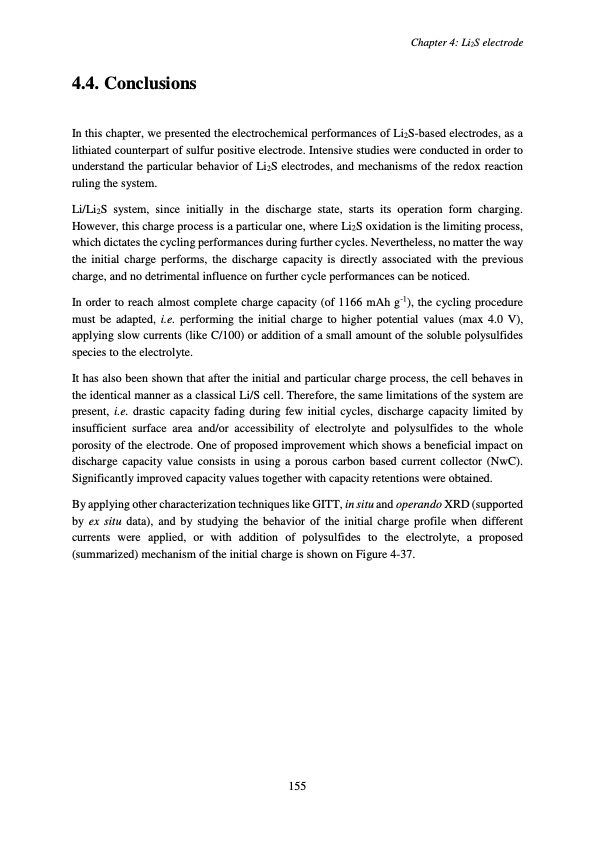
PDF Publication Title:
Text from PDF Page: 159
4.4. Conclusions In this chapter, we presented the electrochemical performances of Li2S-based electrodes, as a lithiated counterpart of sulfur positive electrode. Intensive studies were conducted in order to understand the particular behavior of Li2S electrodes, and mechanisms of the redox reaction ruling the system. Li/Li2S system, since initially in the discharge state, starts its operation form charging. However, this charge process is a particular one, where Li2S oxidation is the limiting process, which dictates the cycling performances during further cycles. Nevertheless, no matter the way the initial charge performs, the discharge capacity is directly associated with the previous charge, and no detrimental influence on further cycle performances can be noticed. In order to reach almost complete charge capacity (of 1166 mAh g-1), the cycling procedure must be adapted, i.e. performing the initial charge to higher potential values (max 4.0 V), applying slow currents (like C/100) or addition of a small amount of the soluble polysulfides species to the electrolyte. It has also been shown that after the initial and particular charge process, the cell behaves in the identical manner as a classical Li/S cell. Therefore, the same limitations of the system are present, i.e. drastic capacity fading during few initial cycles, discharge capacity limited by insufficient surface area and/or accessibility of electrolyte and polysulfides to the whole porosity of the electrode. One of proposed improvement which shows a beneficial impact on discharge capacity value consists in using a porous carbon based current collector (NwC). Significantly improved capacity values together with capacity retentions were obtained. By applying other characterization techniques like GITT, in situ and operando XRD (supported by ex situ data), and by studying the behavior of the initial charge profile when different currents were applied, or with addition of polysulfides to the electrolyte, a proposed (summarized) mechanism of the initial charge is shown on Figure 4-37. 155 Chapter 4: Li2S electrodePDF Image | Accumulateur Lithium Soufre

PDF Search Title:
Accumulateur Lithium SoufreOriginal File Name Searched:
WALUS_2015_archivage.pdfDIY PDF Search: Google It | Yahoo | Bing
Sulfur Deposition on Carbon Nanofibers using Supercritical CO2 Sulfur Deposition on Carbon Nanofibers using Supercritical CO2. Gamma sulfur also known as mother of pearl sulfur and nacreous sulfur... More Info
CO2 Organic Rankine Cycle Experimenter Platform The supercritical CO2 phase change system is both a heat pump and organic rankine cycle which can be used for those purposes and as a supercritical extractor for advanced subcritical and supercritical extraction technology. Uses include producing nanoparticles, precious metal CO2 extraction, lithium battery recycling, and other applications... More Info
| CONTACT TEL: 608-238-6001 Email: greg@infinityturbine.com | RSS | AMP |